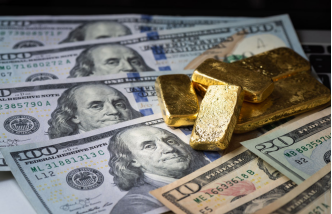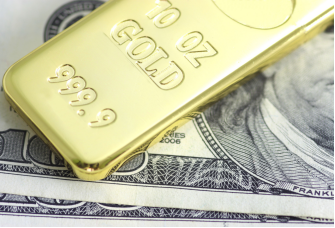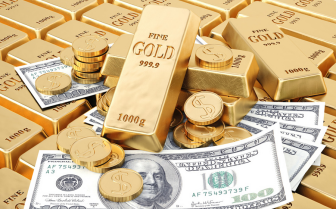On Monday (May 16), spot gold once experienced a wave of short-term diving, falling $20 to a minimum of $1786.50 within half an hour, and then rebounded moderately to around the 1800 mark, closing at $1824.76 an ounce.
Can gold be bargained for?
Generally speaking, when the real interest rate in the United States goes down to the zero axis or even negative, the trend of gold is usually in an upward trend, and when the real interest rate in the United States goes up to the zero axis or even turns to a positive value, Gold is usually in a downtrend.
After the 2008 financial crisis, the Federal Reserve launched several rounds of interest rate cuts and quantitative easing to save the economy. The real interest rate in the United States broke through the zero axis, and the real interest rate turned negative. With the negative real interest rates in the United States, a relatively rapid and rapid rise in the market has begun.
This upward trend continued until early 2013 when the Federal Reserve signaled a rate hike. At this stage, the real interest rate in the United States has begun to rise from a negative value, and has begun to move closer to the zero axis and gradually move towards a positive value. By the first quarter of 2013, the real interest rate in the United States had moved from negative to zero.
During the period from the first quarter of 2013 to the beginning of 2019, since the United States was in the three-step stage of taper, interest rate hike and balance sheet reduction, the real interest rate was always positive, but the new crown epidemic disrupted everything, and the unprecedented large scale after the epidemic With the support of easing, the real interest rate has moved to a negative position, and gold has begun to break upwards, out of a wave of rapid rise in the market.
The recent Fed tightening has already begun. This tightening can be said to be the fastest tightening in the past ten years. In the short interest rate hike cycle in the last round, from taper to interest rate hike and balance sheet reduction, the interval between each action is about the same. two years. But the three actions of taper, interest rate hike and balance sheet reduction this time are very fast, almost simultaneously completed within half a year.
When the real interest rate in the United States begins to turn positive, it means that gold, a currency with no interest, becomes less and less cost-effective. In this case, the follow-up may be faced with a new round of investors' selling of gold, rather than continuing to buy.
Why is the dollar soaring
The closely-watched U.S. dollar index has risen 7 percent since January to its highest level in two years as the U.S. Federal Reserve hiked rates aggressively to curb inflation and investors took the greenback as a safe haven amid economic uncertainty.
The soaring dollar is pushing up borrowing costs and exacerbating financial market volatility, pushing the global economy further into a synchronized slowdown in growth with little respite in sight.
While a stronger dollar would help the Fed cool inflation and support U.S. demand for foreign goods, it could also push up import prices for economies other than the U.S., further boosting their inflation and undermining capital.
This round of U.S. dollar index rise almost started in May 2021, rising from about 90 to the current 104.5, an appreciation of 16% in about one year. The intraday high on May 13 once exceeded 105. Judging from the monetary policy choices currently facing economies in the US dollar index, the US dollar index is likely to hit 110.
From the perspective of the euro, the two major challenges facing the euro zone economy: the huge negative impact on the European economy caused by the Russian-Ukrainian geopolitical conflict and high inflation. The former problem is a political problem, the latter is an economic problem, but the political problem exacerbates the economic problem. The ECB faces the dual pressure of external political conflict and internal inflation. Judging from the five rounds of sanctions introduced by the EU and the sixth round of sanctions that are still brewing, the comprehensive "decoupling" between the EU and Russia is a high probability event. The unemployment rate in the euro area is currently 6.8%, which is lower than the level before the epidemic, and the inflation rate (HICP) in April was as high as 7.5% year-on-year.
The inflationary pressure in the euro area mainly comes from the shock of imported energy prices, and the wage price spiral mechanism has not yet appeared in the euro area. Although monetary policy in the euro area has a limited effect on "import inflation", prices of goods and services excluding energy and food are currently increasing at an annual rate of 3.5%, which is more than double the historical average prices in the euro area before the impact of the epidemic. Inflationary pressures forced the ECB to start discussions on the normalization of monetary policy.
The destruction of anti-globalization begins
The current global spread of inflation can be seen as the revenge of globalization. Behind the reversal of globalization are both natural factors such as the new crown epidemic and political factors represented by the trade war, but no matter which factor, it means that the global allocation of resources is no longer only in accordance with economic laws, but also in accordance with the principle of efficiency.
It is difficult to break the easy and it is not known whether the loss of efficiency can bring about fairness, but the change in the rules of resource allocation will immediately get the retaliation against globalization marked by high global inflation. According to data released by Eurostat on April 29, 2022, due to the sharp rise in energy and food prices, the inflation rate in the euro area reached an annual rate of 7.5% in April, setting a record high since statistics began in 1997 for the sixth consecutive month. .
The latest U.S. inflation reading is a 40-year high in 1982, and UK inflation is a 30-year high. According to the statistics of the Bank for International Settlements, the inflation rate of 60% of developed countries in the world has increased by more than 5% year-on-year, which is the highest proportion since the 1980s.
In addition to the epidemic, the greater threat to globalization comes from the political field. The most typical representative in this regard is the impact of the Russian-Ukrainian conflict on the global prices of oil and natural gas, wheat, corn, sunflower oil and some non-ferrous metals represented by aluminum and nickel.
The retaliation brought to us by deglobalization is the upward shift of the global aggregate supply curve, which means that if we want to obtain the same goods and services, we must pay higher prices, otherwise we will suffer the loss of welfare levels. Behind this, the impact of the epidemic may subside, but no one can predict where the global economy will go in the future.
 2022-05-17
2022-05-17
 1170
1170







 简体中文
简体中文
 ภาษาไทย
ภาษาไทย
 繁體中文
繁體中文
 Indonesia
Indonesia











